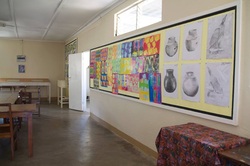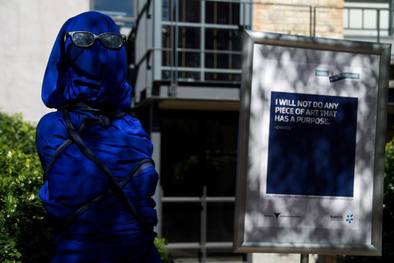“Yes! I’m going to be in southern Africa for-“
“Africa?! Are you building houses or something?”
“No actually I’ll be in Zimbabwe and –“
“Zimbabwe?! Make sure you get your shots. And be safe! You could get kidnapped!”
“I’ll be there for two weeks, then over to South Africa for – “
“Oh South Africa! Like Cape Town? I hear it’s beautiful there. Have fun”
This was a common conversation I continually had leading up to my departure in May. It appeared that quite a few of my friends and family members had misconceptions about Africa, which is a continent far too large to stereotype or define under any single image. Admittedly, I too had expectations of the continent that I had accumulated over years of skewed media images, biased textbook passages and just general conversations that led me to believe Africa was inherently poor, unsafe and damaged – a place that needed vigilant American souls like myself to come fix it. Of course, this is a crude overstatement of sentiments I now know are untrue, but reflect the general American understanding of the nations abroad. (That and lions – everyone seems to think that lions just walk up and down the street willy-nilly all over the place, but that’s not true either.) So I was leaving America expecting my life to be touched by the poverty and poor souls of the African nations, and that through this experience I would find a solution, a way to do my part in helping to “fix” Africa. In the following month, I learned more than I had ever learned in a classroom, and I grew to understand just how narrow-minded the picture I had of southern Africa was before I saw it for myself.
So how do I even begin to describe the last month of my life? I could tell you through stories – anecdotal snippets of the people I met and the places I saw; I could tell you through photographs – visual evidence of the culture that blew my mind, the nature that overwhelmed me with awe and wonder. I could show you my souvenirs, the tan lines or my daily journal, but in reality, no words, images or expressions could capture the freedom I felt and the total connection with the world I experienced while I was in Africa.
We started in Zimbabwe; jet-lagged and already a little culture-shocked by the genuine kindness of airline officials (something foreign to American institutions). We were met at the Harare airport by our guide, Blessing, who proved to live up to his name in more ways than I could have imagined. We boarded the bus we would call our home for the next two weeks, and drove off to our rooms for the night. Even in the darkness, I could feel the purity of the landscape passing by us. The baobabs (or as we fondly nicknamed them, Lion-King-Trees) stood out like something from a postcard. I remember watching the moon rise behind one and losing my breath, knowing that I was really there, experiencing a new world I couldn’t wait to explore.
If I detailed my journey day by day, I would lose you in a mess of museums, guided tours, hikes, schoolyards and conversations, all strung together through friendships and emotions that I could never replicate in words. Instead, throughout the next few posts, I want to summarize the high points of my experiences as they relate to my developed interests of art, education and cultural issues. In most instances, these three intersect, creating an intricate and delicate balance of historical and contemporary culture that define southern Africa in both local and global contexts.
(a middle portion of the reflection has been removed: read here)
 One art room at Peter House Boarding School
One art room at Peter House Boarding School  Student at Main Camp Primary in Hwange, Zimbabwe plays music with a broken mallet.
Student at Main Camp Primary in Hwange, Zimbabwe plays music with a broken mallet. With incredible talent and drive, they created their own music and dance routines that incorporate both traditional and contemporary movements, as well as capturing group dynamics and individual personalities. Seeing these kids perform, and then interacting with them afterward, was a moment of clarity as I saw once again how the overlap of the arts, education and culture created a beneficial experience for all involved. Not only did the program give children a safe and enriching after-school activity, a hot meal, and something to be proud of, it also gave them an outlet of cross-cultural interaction and understanding. Seeing a program like this inspired me to consider how, as an art educator, I can create my own community influence. Wherever I end up in life, I want to help create that same sense of love and community that I felt in Langa.
 Performers at the Hlofeni Dance Company
Performers at the Hlofeni Dance Company “You can teach someone how to dance, but you can’t teach them how to feel,” he told me.
This is definitely a teaching philosophy I would like to adopt into my own future classroom and art practice. By encouraging creative and personal content in visual art, I will enable kids as creative thinkers, critical decision makers, and hopefully create a safe space where children are free to be themselves in a world that consistently tells them differently. To me, these qualities are much more valuable than how well you can mix your paints or blend your pastels. These are life skills that transcend beyond the canvas or pottery wheel and in to everyday life, making individuals more adept and societies stronger.
In terms of artistic processes and products, I learned an unimaginable amount in one month. There were skills and practice methods I picked up from observing artists in their studios at Durban, the galleries in Johannesburg or even those working around curio shops throughout the southern tier. Most of the visual art we had experienced in Zimbabwe had a traditional basis or were items produced for sale in tourist shops to appease visitors who have a set idea of what they want “true African art” to look like (again, leading me to question the cultural implications and moral contradictions of tourist art.) I knew that there is a huge blooming contemporary art scene in southern Africa but I had not exactly experienced that until we reached the larger cities of South Africa.
I was curious as to where the balance would fall, if any, between modern themes/practices and traditional, local art forms. It is the age-old question of “How do we adapt to modern global culture without losing our own traditions?”
I could start to see this balance at the Bat Centre galleries and studio centers at the harbor in Durban. There were quite a few visual artists there that showed their global influences (in either content or technique) in conjunction with traditional practices. One artist produced large oil paintings of contemporary black celebrities, however he had portrayed them dressed in traditional Zulu kings-ware. Another group of printmaking artists I spoke to showed me how they use the Chinese inspired carving prints to portray vivid African landscapes, wildlife or cultural objects. There was certainly a wider range of styles and interests in these spaces than I had seen in any curio or craft market, and the global influence was undoubtedly embraced.
The art scene in Johannesburg was again a completely different experience than what I had seen previously from the region. I was surprised to find that what we saw in Durban was comparatively more underground and urban than the Arts on Main warehouse building we visited in downtown Johannesburg. This art market set up had a wide array of galleries and shops that overall embodied much more of a direct European boutique culture and American media influence, combined slightly with traditional African designs.

It was in the courtyard of this warehouse where I encountered what I thought to be the most subtly obvious evidence of European influence and colonial pressure in the art world of southern Africa. There was a sculpture: a figure wrapped in blue fabric wearing sunglasses and tied tight with rope, standing next to a sign displaying a quote from Bulgarian artist Christo, “I WILL NOT DO ANY PIECE OF ART THAT HAS A PURPOSE”. Now, this quote is actually about the artist’s beliefs towards propagandistic art projects, but with those words alone, out of context, I couldn’t help but notice the total contrast between what I had observed in all the tradition art practices of the Zulu, Xhosa and other native peoples.
I don’t think there is a correct reason for making art – purpose or no purpose, but I am curious as to how to the uses of art changed in southern Africa due to European influence. Art and history collide again to create the world we live in today, and it goes beyond just process and aesthetic and in to actual functionality and reasoning behind works.
Being able to discover the variations between the art of certain cities and regions for myself gave me powerful insight in to what defines a visual culture and how it is integrated with social, political and economic cultures of these spaces. These artistic experiences are ones I will never forget, and plan on incorporating in my own pedagogy and art classrooms in the future.
The past month has made me reevaluate how I approach everything from art, history, and education to politics, people and cultures.
So when I return to campus in the fall, and people ask me how my summer was, I will tell them how my life was changed in a month. When they ask if I “built houses in Africa”, I won’t let them cut me off when I answer. If I get asked about tribal dances, I’ll explain the amazing traditional elements we saw while reminding them these elements are only a fraction of what the entire picture of southern Africa looks like. It is not just “huts and watering holes”, there are cities and skyscrapers and suburbs and everything in between.
When people call me “brave” for going in to places they believe unsafe for a tiny white American girl, I’ll try not to laugh when I explain how I felt much safer in the African townships than I would walking down Fraternity Row on any given college campus.
When people ask if I found the answer, if I know how to “fix” Africa, I will shake my head.
“No,” I will say. “Africa cannot be fixed.”
Africa cannot be fixed. Africa cannot be fixed, because it does not need fixing. It is our perceptions and perspectives that need renovation. Africa, like any country, (yes, even our beloved Red, White and Blue) needs improvement. The areas we visited still struggle with poverty, the growing gap between rich and poor, and stark racism lingering even twenty years after the end of apartheid. But Africa is not helpless; the people of Africa are improving themselves and their communities to create changes that will outlast a purchase of Toms or other oh-so-charitable donations. We saw this in the townships, with people like Rosie and Siviwe who built self-sustaining businesses from the ground up, providing their communities with enriching opportunities and benefits beyond what any tangible American donation could give.
View all pictures from southern Africa

